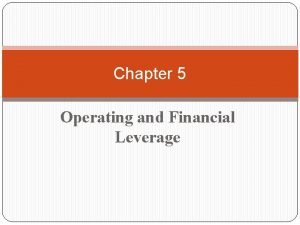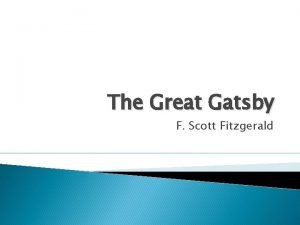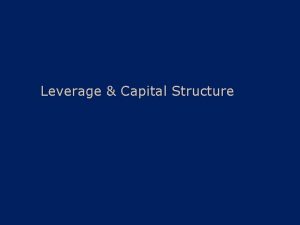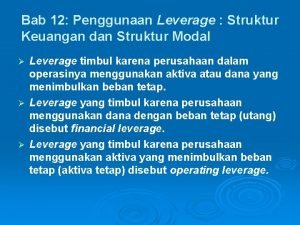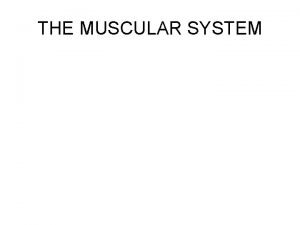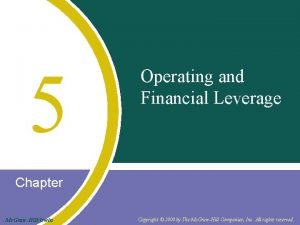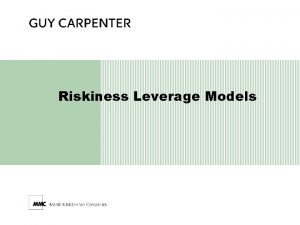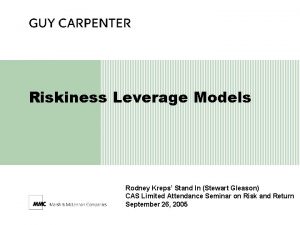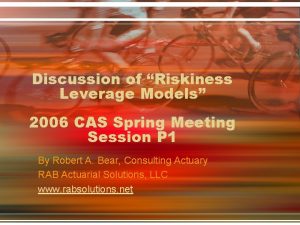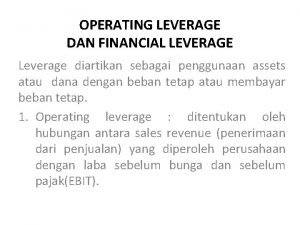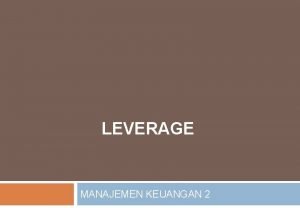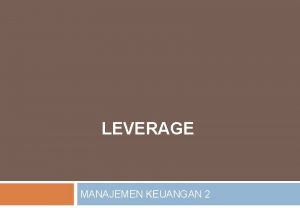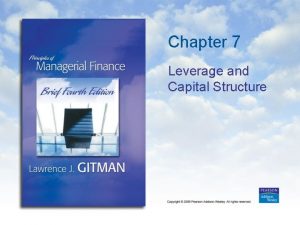Riskiness Leverage Models Riskiness Leverage Models n n










- Slides: 10

Riskiness Leverage Models

Riskiness Leverage Models n n n AKA RMK algorithm Capital can be allocated to any level of detail in a completely additive fashion. Riskiness only needs to be defined on the total, and can be done so intuitively. Many functional forms of risk aversion are possible. All the usual forms can be expressed, allowing comparisons on a common basis. Simple to do in simulation situation.

Riskiness Leverage Models n n n Start with N random variables (think underwriting and other cash flows) and their total Riskiness be expressed as the mean value of a linear functional in the total times an arbitrary function depending only on the total. Simple example: functional is variable minus constant times the mean of the variable.

Riskiness Leverage Models n n The allocation of the riskiness to an individual variable is Surplus, risk load or whatever can be allocated proportionally and everything will add no matter what the dependency structure. These are referred to a co-measures, in analogy with the simple examples of covariance, co-skewness, and so on. Covariance and higher powers have a = 1 and

TVAR as Riskiness Leverage n TVAR has (1) functional = variable and (2) leverage zero below some value corresponding to a percentile , and constant above it: n This can be re-framed as n and individual riskiness as

EPD as Riskiness Leverage n Expected Policyholder Deficit has (1) functional = variable - some value and (2) leverage zero below the value and 1 above it: n This is n and individual riskiness as

Riskiness Leverage Examples Va. R: L x TVa. R: L x Semivariance: L m x

Generic Riskiness Leverage for management should n n be a down side measure (the accountant’s point of view); be more or less constant for excess that is small compared to capital (risk of not making plan, but also not a disaster); become much larger for excess significantly impacting capital; and go to zero (or at least not increase) for excess significantly exceeding capital – once you are buried it doesn’t matter how much dirt is on top.

How to choose measures? n n Try out various measures on simulation to see how different they are. Try out various measures on past history to see what would have guided you well. Try out various measures on different levels of management to see what kind of buy-in you can get. Run candidates in parallel with current processes for a while to see what they suggest.

A miniature company portfolio example n n n ABC Mini-DFA. xls is a spreadsheet representation of a company with two lines of business. How do we as company management look at the business? “For the x percent of possibilities of net income that are less than $BAD we want the surplus to be a prudent multiple of the average value so that we can go on in business. ” Looking at the numbers quantifies x% as 2% and prudent as 1. 5. Two lessons from the model: – Returns on allocated surplus can be VERY misleading and need careful interpretation. – that we do not need to know what the reinsurer’s rate of return is on a contract to know how good or bad it is for us.
 Operating leverage and financial leverage formula
Operating leverage and financial leverage formula Modals and semimodals
Modals and semimodals Operating and financial leverage chapter 5
Operating and financial leverage chapter 5 Persuasive leverage
Persuasive leverage It was a body capable of enormous leverage
It was a body capable of enormous leverage Secondary source of brand knowledge
Secondary source of brand knowledge Capital structure leverage
Capital structure leverage Leverage dan struktur modal
Leverage dan struktur modal Muscles of the posterior leg
Muscles of the posterior leg Leverage percentage
Leverage percentage Lift and leverage
Lift and leverage


